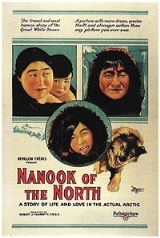
Nanook of the North
Overview
1922 in film
-Events:* June 11 - United States première of Robert J. Flaherty's Nanook of the North, the first commercially successful feature length documentary film....
silent documentary film
Documentary film
Documentary films constitute a broad category of nonfictional motion pictures intended to document some aspect of reality, primarily for the purposes of instruction or maintaining a historical record...
by Robert J. Flaherty
Robert J. Flaherty
Robert Joseph Flaherty, F.R.G.S. was an American filmmaker who directed and produced the first commercially successful feature length documentary film, Nanook of the North...
. In the tradition of what would later be called salvage ethnography
Salvage ethnography
Salvage ethnography is a term used by anthropologists beginning in the 1960s used as part of a critique of 19th century ethnography and early modern anthropology. The term was coined by Jacob Gruber, who identified its emergence with 19th century ethnographers documenting the languages of peoples...
, Flaherty captured the struggles of the Inuk
Inuit
The Inuit are a group of culturally similar indigenous peoples inhabiting the Arctic regions of Canada , Denmark , Russia and the United States . Inuit means “the people” in the Inuktitut language...
Nanook and his family in the Canadian
Canada
Canada is a North American country consisting of ten provinces and three territories. Located in the northern part of the continent, it extends from the Atlantic Ocean in the east to the Pacific Ocean in the west, and northward into the Arctic Ocean...
arctic
Arctic
The Arctic is a region located at the northern-most part of the Earth. The Arctic consists of the Arctic Ocean and parts of Canada, Russia, Greenland, the United States, Norway, Sweden, Finland, and Iceland. The Arctic region consists of a vast, ice-covered ocean, surrounded by treeless permafrost...
. The film is considered the first feature-length documentary, though Flaherty has been criticized for staging several sequences and thereby distorting the reality of his subjects' lives.
In 1989, this film was one of the first 25 films to be selected for preservation in the United States National Film Registry
National Film Registry
The National Film Registry is the United States National Film Preservation Board's selection of films for preservation in the Library of Congress. The Board, established by the National Film Preservation Act of 1988, was reauthorized by acts of Congress in 1992, 1996, 2005, and again in October 2008...
by the Library of Congress
Library of Congress
The Library of Congress is the research library of the United States Congress, de facto national library of the United States, and the oldest federal cultural institution in the United States. Located in three buildings in Washington, D.C., it is the largest library in the world by shelf space and...
as being "culturally, historically, or aesthetically significant".
The film was shot near Inukjuak
Inukjuak, Quebec
Inukjuak , alternatively spelled Inoucdjouac, former name and current postal name Port Harrison, is an Inuit settlement located on Hudson Bay at the mouth of the Innuksuak River in the Nunavik region of northern Quebec, Canada. Its population is 1,294...
, on Hudson Bay
Hudson Bay
Hudson Bay , sometimes called Hudson's Bay, is a large body of saltwater in northeastern Canada. It drains a very large area, about , that includes parts of Ontario, Quebec, Saskatchewan, Alberta, most of Manitoba, southeastern Nunavut, as well as parts of North Dakota, South Dakota, Minnesota,...
in northern Quebec
Quebec
Quebec or is a province in east-central Canada. It is the only Canadian province with a predominantly French-speaking population and the only one whose sole official language is French at the provincial level....
, Canada.

